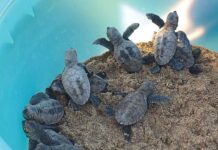Much of what biologists know about pupu kuahiwi, or Hawaiian land snails, comes from nineteenth-century naturalists such as David Dwight Baldwin. In the late 1800s, the missionary’s son amassed 1,144 land-snail specimens from five islands. He became an authority on the subject, publishing the first scientific catalog of Hawaiian land snails. He named several species and even more were named in his honor.
The shells that Baldwin and other collectors culled from island forests are gemlike, bright daubs of colors and patterns: jade green as shiny as hard candy, yellow with mahogany and cream stripes, and fiery red with umber zigzags. They’ve lost little of their luster over the past century, and can be viewed at several local museums, including the Baldwin House and Bailey House on Maui, and the Bishop Museum on O‘ahu.
The diversity of pupu kuahiwi is astonishing; in fact, they rank among the planet’s most remarkable examples of evolutionary radiation. Scientists estimate that the Hawaiian snails’ ancestors arrived in the Islands several million years ago. Over many generations, the twenty-odd pioneer species evolved into ten unique families and as many as 1,400 species. Ninety-nine percent are endemic to Hawai‘i, found nowhere else on earth. Some species hail from a single island, even a single valley.




